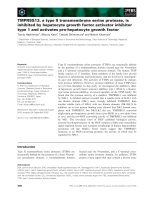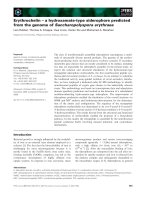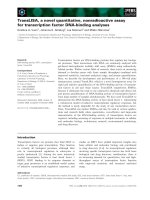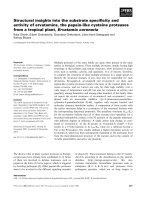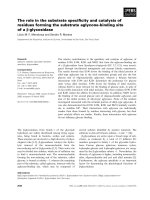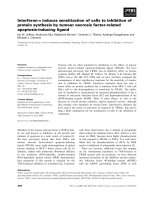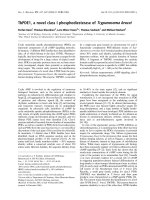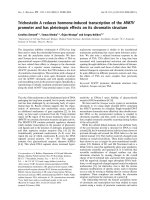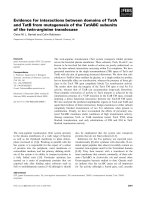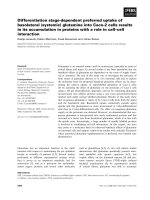Báo cáo khoa học: "Bootstrapping a Unified Model of Lexical and Phonetic Acquisition" potx
Bạn đang xem bản rút gọn của tài liệu. Xem và tải ngay bản đầy đủ của tài liệu tại đây (267.48 KB, 10 trang )
Proceedings of the 50th Annual Meeting of the Association for Computational Linguistics, pages 184–193,
Jeju, Republic of Korea, 8-14 July 2012.
c
2012 Association for Computational Linguistics
Bootstrapping a Unified Model of Lexical and Phonetic Acquisition
Micha Elsner
ILCC, School of Informatics
University of Edinburgh
Edinburgh, EH8 9AB, UK
Sharon Goldwater
ILCC, School of Informatics
University of Edinburgh
Edinburgh, EH8 9AB, UK
Jacob Eisenstein
School of Interactive Computing
Georgia Institute of Technology
Atlanta, GA, 30308, USA
Abstract
During early language acquisition, infants must
learn both a lexicon and a model of phonet-
ics that explains how lexical items can vary
in pronunciation—for instance “the” might be
realized as or . Previous models of ac-
quisition have generally tackled these problems
in isolation, yet behavioral evidence suggests
infants acquire lexical and phonetic knowledge
simultaneously. We present a Bayesian model
that clusters together phonetic variants of the
same lexical item while learning both a lan-
guage model over lexical items and a log-linear
model of pronunciation variability based on ar-
ticulatory features. The model is trained on
transcribed surface pronunciations, and learns
by bootstrapping, without access to the true
lexicon. We test the model using a corpus of
child-directed speech with realistic phonetic
variation and either gold standard or automati-
cally induced word boundaries. In both cases
modeling variability improves the accuracy of
the learned lexicon over a system that assumes
each lexical item has a unique pronunciation.
1 Introduction
Infants acquiring their first language confront two
difficult cognitive problems: building a lexicon of
word forms, and learning basic phonetics and phonol-
ogy. The two tasks are closely related: knowing what
sounds can substitute for one another helps in clus-
tering together variant pronunciations of the same
word, while knowing the environments in which par-
ticular words can occur helps determine which sound
changes are meaningful and which are not (Feldman
(a) intended:
(b) surface:
(c) unsegmented:
(d) idealized:
Figure 1: The utterances you want one? want a cookie?
represented (a) using a canonical phonemic encoding for
each word and (b) as they might be pronounced phoneti-
cally. Lines (c) and (d) remove the word boundaries (but
not utterance boundaries) from (b) and (a), respectively.
et al., 2009). For instance, if an infant who already
knows the word “you” encounters a new word
, they must decide whether it is a new lexical item
or a variant of the word they already know. Evidence
for the correct conclusion comes from the pronun-
ciation (many English vowels are reduced to [ ] in
unstressed positions) and the context—if the next
word is “want”, “you” is a plausible choice.
To date, most models of infant language learn-
ing have focused on either lexicon-building or pho-
netic learning in isolation. For example, many mod-
els of word segmentation implicitly or explicitly
build a lexicon while segmenting the input stream
of phonemes into word tokens; in nearly all cases
the phonemic input is created from an orthographic
transcription using a phonemic dictionary, thus ab-
stracting away from any phonetic variability (Brent,
1999; Venkataraman, 2001; Swingley, 2005; Gold-
water et al., 2009, among others). As illustrated
in Figure 1, these models attempt to infer line (a)
from line (d). However, (d) is an idealization: real
speech has variability, and behavioral evidence sug-
gests that infants are still learning about the phonetics
and phonology of their language even after beginning
to segment words, rather than learning to neutralize
184
the variations first and acquiring the lexicon after-
wards (Feldman et al., 2009, and references therein).
Based on this evidence, a more realistic model of
early language acquisition should propose a method
of inferring the intended forms (Figure 1a) from the
unsegmented surface forms (1c) while also learning a
model of phonetic variation relating the intended and
surface forms (a) and (b). Previous models with sim-
ilar goals have learned from an artificial corpus with
a small vocabulary (Driesen et al., 2009; R
¨
as
¨
anen,
2011) or have modeled variability only in vowels
(Feldman et al., 2009); to our knowledge, this paper
is the first to use a naturalistic infant-directed corpus
while modeling variability in all segments, and to
incorporate word-level context (a bigram language
model). Our main contribution is a joint lexical-
phonetic model that infers intended forms from seg-
mented surface forms; we test the system using in-
put with either gold standard word boundaries or
boundaries induced by an existing unsupervised seg-
mentation model (Goldwater et al., 2009). We show
that in both cases modeling variability improves the
accuracy of the learned lexicon over a system that
assumes each intended form has a unique surface
form.
Our model is conceptually similar to those used
in speech recognition and other applications: we
assume the intended tokens are generated from a bi-
gram language model and then distorted by a noisy
channel, in particular a log-linear model of phonetic
variability. But unlike speech recognition, we have
no
intended-form, surface-form
training pairs to
train the phonetic model, nor even a dictionary of
intended-form strings to train the language model.
Instead, we initialize the noise model using feature
weights based on universal linguistic principles (e.g.,
a surface phone is likely to share articulatory features
with the intended phone) and use a bootstrapping
process to iteratively infer the intended forms and
retrain the language model and noise model. While
we do not claim that the particular inference mech-
anism we use is cognitively plausible, our positive
results further support the claim that infants can and
do acquire phonetics and the lexicon in concert.
2 Related work
Our work is inspired by the lexical-phonetic model
of Feldman et al. (2009). They extend a model for
clustering acoustic tokens into phonetic categories
(Vallabha et al., 2007) by adding a lexical level that
simultaneously clusters word tokens (which contain
the acoustic tokens) into lexical entries. Including
the lexical level improves the model’s phonetic cat-
egorization, and a follow-up study on artificial lan-
guage learning (Feldman, 2011) supports the claim
that human learners use lexical knowledge to distin-
guish meaningful from unimportant phonetic con-
trasts. Feldman et al. (2009) use a real-valued rep-
resentation for vowels (formant values), but assume
no variability in consonants, and treat each word to-
ken independently. In contrast, our model uses a
symbolic representation for sounds, but models vari-
ability in all segment types and incorporates a bigram
word-level language model.
To our knowledge, the only other lexicon-building
systems that also learn about phonetic variability are
those of Driesen et al. (2009) and R
¨
as
¨
anen (2011).
These systems learn to represent lexical items and
their variability from a discretized representation of
the speech stream, but they are tested on an artifi-
cial corpus with only 80 vocabulary items that was
constructed so as to “avoid strong word-to-word de-
pendencies” (R
¨
as
¨
anen, 2011). Here, we use a natu-
ralistic corpus, demonstrating that lexical-phonetic
learning is possible in this more general setting and
that word-level context information is important for
doing so.
Several other related systems work directly from
the acoustic signal and many of these do use natu-
ralistic corpora. However, they do not learn at both
the lexical and phonetic/acoustic level. For example,
Park and Glass (2008), Aimetti (2009), Jansen et al.
(2010), and McInnes and Goldwater (2011) present
lexicon-building systems that use hard-coded acous-
tic similarity measures rather than learning about
variability, and they only extract and cluster a few
frequent words. On the phonetic side, Varadarajan et
al. (2008) and Dupoux et al. (2011) describe systems
that learn phone-like units but without the benefit of
top-down information.
A final line of related work is on word segmenta-
tion. In addition to the models mentioned in Section
1, which use phonemic input, a few models of word
segmentation have been tested using phonetic input
(Fleck, 2008; Rytting, 2007; Daland and Pierrehum-
bert, 2010). However, they do not cluster segmented
185
Figure 2: Our generative model of the surface tokens
s
from intended tokens
x
, which occur with left and right
contexts l and r.
word tokens into lexical items (none of these mod-
els even maintains an explicit lexicon), nor do they
model or learn from phonetic variation in the input.
3 Lexical-phonetic model
Our lexical-phonetic model is defined using the stan-
dard noisy channel framework: first a sequence of
intended word tokens is generated using a language
model, and then each token is transformed by a proba-
bilistic finite-state transducer to produce the observed
surface sequence. In this section, we present the
model in a hierarchical Bayesian framework to em-
phasize its similarity to existing models, in particu-
lar those of Feldman et al. (2009) and Goldwater et
al. (2009). In our actual implementation, however,
we use approximation and MAP point estimates to
make our inference process more tractable; we dis-
cuss these simplifications in Section 4.
Our observed data consists of a (segmented) se-
quence of surface words
s
1
. . . s
n
. We wish to re-
cover the corresponding sequence of intended words
x
1
. . . x
n
. As shown in Figure 2,
s
i
is produced from
x
i
by a transducer
T
:
s
i
∼ T (x
i
)
, which models
phonetic changes. Each
x
i
is sampled from a dis-
tribution
θ
which represents word frequencies, and
its left and right context words,
l
i
and
r
i
, are drawn
from distributions conditioned on
x
i
, in order to cap-
ture information about the environments in which
x
i
appears:
l
i
∼ P
L
(x
i
), r
i
∼ P
R
(x
i
)
. Because the
number of word types is not known in advance,
θ
is
drawn from a Dirichlet process
DP (α)
, and
P
L
(x)
and
P
R
(x)
have Pitman-Yor priors with concentra-
tion parameter 0 and discount d (Teh, 2006).
Our generative model of
x
i
is unusual for two rea-
sons. First, we treat each
x
i
independently rather
than linking them via a Markov chain. This makes
the model deficient, since
l
i
overlaps with
x
i−1
and
so forth, generating each token twice. During in-
ference, however, we will never compute the joint
probability of all the data at once, only the prob-
abilities of subsets of the variables with particular
intended word forms
u
and
v
. As long as no two of
these words are adjacent, the deficiency will have no
effect. We make this independence assumption for
computational reasons—when deciding whether to
merge
u
and
v
into a single lexical entry, we compute
the change in estimated probability for their contexts,
but not the effect on other words for which
u
and
v
themselves appear as context words.
Also unusual is that we factor the joint probabil-
ity
(l, x, r)
as
p(x)p(l|x)p(r|x)
rather than as a left-
to-right chain
p(l)p(x|l)p(r|x)
. Given our indepen-
dence assumption above, these two quantities are
mathematically equivalent, so the difference matters
only because we are using smoothed estimates. Our
factorization leads to a symmetric treatment of left
and right contexts, which simplifies implementation:
we can store all the context parameters locally as
P
L
(·|x) rather than distributed over various P (x|·).
Next, we explain our transducer
T
. A weighted
finite-state transducer (WFST) is a variant of a finite-
state automaton (Pereira et al., 1994) that reads an
input string symbol-by-symbol and probabilistically
produces an output string; thus it can be used to
specify a conditional probability on output strings
given an input. Our WFST (Figure 3) computes a
weighted edit distance, and is implemented using
OpenFST (Allauzen et al., 2007). It contains a state
for each triplet of (previous, current, next) phones;
conditioned on this state, it emits a character out-
put which can be thought of as a possible surface
realization of current in its particular environment.
The output can be the empty string
, in which case
current is deleted. The machine can also insert char-
acters at any point in the string, by transitioning to an
insert state (previous,
, current) and then returning
while emitting some new character.
The transducer is parameterized by the probabil-
ities of the arcs. For instance, all arcs leaving the
state
(•,
, i
)
consume the character and emit some
character
c
with probability
p(c|•,
, i
)
. Following
186
Figure 3: The fragment of the transducer responsible for
input string “the”. “ ” represents an output arc for
each possible character, including the empty string
;
•
is
the word boundary marker.
Dreyer et al. (2008), we parameterize these distribu-
tions with a log-linear model. The model features are
based on articulatory phonetics and distinguish three
dimensions of sound production: voicing, place of
articulation and manner of articulation.
Features are generated from four positional tem-
plates (Figure 4): (curr)
→
out, (prev, curr)
→
out,
(curr, next)
→
out and (prev, curr, next)
→
out. Each
template is instantiated once per articulatory dimen-
sion, with prev, curr, next and out replaced by their
values for that dimension: for instance, there are
two voicing values, voiced and unvoiced
1
and the
(curr)
→
out template for [ ] producing [ ] would
be instantiated as (voiced)
→
voiced. To capture
trends specific to particular sounds, each template
is instantiated again using the actual symbol for
curr and articulatory values for everything else (e.g.,
[ ]
→
unvoiced ). An additional template,
→
out, cap-
tures the marginal frequency of the output symbol.
There are also faithfulness features, same-sound,
same-voice, same-place and same-manner which
check if curr is exactly identical to out or shares
the exact value of a particular feature.
Our choice of templates and features is based on
standard linguistic principles: we expect that chang-
ing only a single articulatory dimension will be more
acceptable than changing several, and that the artic-
ulatory dimensions of context phones are important
because of assimilatory and dissimilatory processes
(Hayes, 2011). In modern phonetics and phonology,
these generalizations are usually expressed as Opti-
mality Theory constraints; log-linear models such as
ours have previously been used to implement stochas-
1
We use seven place values and five manner values (stop,
nasal stop, fricative, vowel, other). Empty segments like
and
•
are assigned a special value “no-value” for all features.
Figure 4: Some features generated for
(•,
, i
) → d
. Each
black factor node corresponds to a positional template.
The features instantiated for the (curr)
→
out and
→
out
template are shown in full, and we show some of the
features for the (curr,next)→out template.
tic Optimality Theory models (Goldwater and John-
son, 2003; Hayes and Wilson, 2008).
4 Inference
Global optimization of the model posterior is diffi-
cult; instead we use Viterbi EM (Spitkovsky et al.,
2010; Allahverdyan and Galstyan, 2011). We begin
with a simple initial transducer and alternate between
two phases: clustering together surface forms, and
reestimating the transducer parameters. We iterate
this procedure until convergence (when successive
clustering phases find nearly the same set of merges);
this tends to take about 5 or 6 iterations.
In our clustering phase, we improve the model
posterior as much as possible by greedily making
type merges, where, for a pair of intended word forms
u
and
v
, we replace all instances of
x
i
= u
with
x
i
= v
. We maintain the invariant that each intended
word form’s most common surface form must be
itself; this biases the model toward solutions with
low distortion in the transducer.
4.1 Scoring merges
We write the change in the log posterior probability
of the model resulting from a type merge of
u
to
v
as
∆(u, v)
, which factors into two terms, one depending
on the surface string and the transducer, and the other
depending on the string of intended words. In order to
ensure that each intended word form’s most common
surface form is itself, we define ∆(u, v) = −∞ if u
is more common than v.
We write the log probability of
x
being transduced
to
s
as
T (s|x)
. If we merge
u
into
v
, we no longer
187
need to produce any surface forms from
u
, but instead
we must derive them from
v
. If
#(·)
counts the
occurrences of some event in the current state of the
model, the transducer component of ∆ is:
∆
T
=
s
#(x
i
=u, s
i
=s)(T (s|v) − T (s|u)) (1)
This term is typically negative, voting against a
merge, since u is more similar to itself than to v.
The language modeling term relating to the in-
tended string again factors into multiple components.
The probability of a particular
l
i
, x
i
, r
i
can be broken
into
p(x
i
)p(l
i
|x
i
)p(r
i
|x
i
)
according to the model.
We deal first with the
p(x
i
)
unigram term, consid-
ering all tokens where
x
i
∈ {u, v}
and computing
the probability
p
u
= p(x
i
= u|x
i
∈ {u, v})
. By
definition of a Dirichlet process, the marginal over a
subset of the variables will be Dirichlet, so for
α > 1
we have the MAP estimate:
p
u
=
#(x
i
=u) + α − 1
#(x
i
∈ {u, v}) + 2(α − 1)
(2)
p
v
= p(x
i
= v|x
i
∈ {u, v})
is computed similarly.
If we decide to merge
u
into
v
, however, the proba-
bility
p(x
i
= v|x
i
∈ {u, v})
becomes 1. The change
in log-probability resulting from the merge is closely
related to the entropy of the distribution:
∆
U
= −#(x
i
=u) log(p
u
)−#(x
i
=v) log(p
v
) (3)
This change must be positive and favors merging.
Next, we consider the change in probability from
the left contexts (the derivations for right contexts are
equivalent). If
u
and
v
are separate words, we gen-
erate their left contexts from different distributions
p(l|u)
and
p(l|v)
, while if they are merged, we must
generate all the contexts from the same distribution
p(l|{u, v}). This change is:
∆
L
=
l
#(l, u){log(p(l|{u, v})) − log(p(l|u)}
+
l
#(l, v){log(p(l|{u, v})) − log(p(l|v)}
In a full Bayesian model, we would integrate over
the parameters of these distributions; instead, we
use Kneser-Ney smoothing (Kneser and Ney, 1995)
which has been shown to approximate the MAP solu-
tion of a hierarchical Pitman-Yor model (Teh, 2006;
Goldwater et al., 2006). The Kneser-Ney discount
2
d
is a tunable parameter of our system, and con-
trols whether the term favors merging or not. If
d
is
small,
p(l|u)
and
p(l|v)
are close to their maximum-
likelihood estimates, and
∆
L
is similar to a Jensen-
Shannon divergence; it is always negative and dis-
courages mergers. As
d
increases, however,
p(l|u)
for rare words approaches the prior distribution; in
this case, merging two words may result in better
posterior parameters than estimating both separately,
since the combined estimate loses less mass to dis-
counting.
Because neither the transducer nor the language
model are perfect models of the true distribution,
they can have incompatible dynamic ranges. Often,
the transducer distribution is too peaked; to remedy
this, we downweight the transducer probability by
λ
, a parameter of our model, which we set to
.5
.
Downweighting of the acoustic model versus the LM
is typical in speech recognition (Bahl et al., 1980).
To summarize, the full change in posterior is:
∆(u, v) = ∆
U
+ ∆
L
+ ∆
R
+ λ∆
T
(4)
There are four parameters. The transducer regular-
ization
r = 1
and unigram prior
α = 2
, which we
set ad-hoc, have little impact on performance. The
Kneser-Ney discount
d = 2
and transducer down-
weight
λ = .5
have more influence and were tuned
on development data.
4.2 Clustering algorithm
In the clustering phase, we start with an initial solu-
tion in which each surface form is its own intended
pronunciation and iteratively improve this solution
by merging together word types, picking (approxi-
mately) the best merger at each point.
We begin by computing a set of candidate mergers
for each surface word type
u
. This step saves time
by quickly rejecting mergers which are certain to get
very low transducer scores. We reject a pair
u, v
if
the difference in their length is greater than 4, or if
both words are longer than 4 segments, but, when
we consider them as unordered bags of segments, the
Dice coefficient between them is less than .5.
For each word
u
and all its candidates
v
, we com-
pute
∆(u, v)
as in Equation 4. We keep track of the
2
We use one discount, rather than several as in modified KN.
188
Input: vocabulary of surface forms u
Input: C(u): candidate intended forms of u
Output: intend(u): intended form of u
foreach u ∈ vocab do
// initialization
v
∗
(u) ← argmax
v ∈ C(u)
∆(u, v);
∆
∗
(u) ← ∆(u, v
∗
(u))
intend(u) ← u
add u to queue Q with priority ∆
∗
(u))
while top(Q) > −∞ do
u ← pop(Q)
recompute v
∗
(u), ∆
∗
(u)
if ∆
∗
(u) > 0 then
// merge u with best merger
intend(u) ← v
∗
(u)
update ∆(x, u) ∀x : v
∗
(x) = u
remove u from C(x) ∀x
update ∆(x, v) ∀x : v
∗
(x) = v
update ∆(v, x) ∀x ∈ C(v)
if updated ∆ > ∆
∗
for any words then
reset ∆
∗
, v
∗
for those words
// (these updates can
increase a word’s priority
from −∞)
else if ∆
∗
(u) = −∞ then
// reject but leave in queue
∆
∗
(u) ← −∞
Algorithm 1: Our clustering phase.
current best target
v
∗
(u)
and best score
∆
∗
(u)
, using
a priority queue. At each step of the algorithm, we
pop the
u
with the current best
∆
∗
(u)
, recompute
its scores, and then merge it with
v
∗
(u)
if doing so
would improve the model posterior. In an exact al-
gorithm, we would then need to recompute most of
the other scores, since merging
u
and
v
∗
(u)
affects
other words for which
u
and
v
∗
(u)
are candidates,
and also words for which they appear in the context
set. However, recomputing all these scores would be
extremely time-consuming.
3
Therefore, we recom-
pute scores for only those words where the previous
best merger was either
u
or
v
∗
(u)
. (If the best merge
would not improve the probability, we reject it, but
since its score might increase if we merge
v
∗
(u)
, we
leave
u
in the queue, setting its
∆
score to
−∞
; this
score will be updated if we merge v
∗
(u).)
Since we recompute the exact scores
∆(u, v)
im-
mediately before merging
u
, the algorithm is guaran-
3
The transducer scores can be cached since they depend only
on surface forms, but the language model scores cannot.
teed never to reduce the posterior probability. It can
potentially make changes in the wrong order, since
not all the
∆
s are recomputed in each step, but most
changes do not affect one another, so performing
them out of order has no impact. Empirically, we
find that mutually exclusive changes (usually of the
form
(u, v)
and
(v, w)
) tend to differ enough in initial
score that they are evaluated in the correct order.
4.3 Training the transducer
To train the transducer on a set of mappings between
surface and intended forms, we find the maximum-
probability state sequence for each mapping (another
application of Viterbi EM) and extract features for
each state and its output. Learning weights is then
a maximum-entropy problem, which we solve using
Orthant-wise Limited-memory Quasi-Newton.
4
To construct our initial transducer, we first learn
weights for the marginal distribution on surface
sounds by training the max-ent system with only the
bias features active. Next, we manually set weights
(Table 1) for insertions and deletions, which do not
appear on the surface, and for faithfulness features.
Other features get an initial weight of 0.
5 Experiments
5.1 Dataset
Our corpus is a processed version of the Bernstein-
Ratner corpus (Bernstein-Ratner, 1987) from
CHILDES (MacWhinney, 2000), which contains or-
thographic transcriptions of parent-child dyads with
infants aged 13-23 months. Brent and Cartwright
(1996) created a phonemic version of this corpus
by extracting all infant-directed utterances and con-
verted them to a phonemic transcription using a dic-
tionary. This version, which contains 9790 utterances
(33399 tokens, 1321 types), is now standard for word
segmentation, but contains no phonetic variability.
Since producing a close phonetic transcription of
this data would be impractical, we instead construct
an approximate phonetic version using information
from the Buckeye corpus (Pitt et al., 2007). Buckeye
is a corpus of adult-directed conversational Ameri-
can English, and has been phonetically transcribed
4
We use the implementation of Andrew and Gao (2007) with
an
l
2
regularizer and regularization parameter
r = 1
; although
this could be tuned, in practice it has little effect on results.
189
Feature Weight
output-is-x marginal p(x)
output-is- 0
same-sound 5
same-{place,voice, manner} 2
insertion -3
Table 1: Initial transducer weights.
“about”
ahbawt:15, bawt:9, ihbawt:4, ahbawd:4, ih-
bawd:4, ahbaat:2, baw:1, ahbaht:1, erbawd:1,
bawd:1, ahbaad:1, ahpaat:1, bah:1, baht:1,
ah:1, ahbahd:1, ehbaat:1, ahbaed:1, ihbaht:1,
baot:1
“wanna”
waanah:94, waanih:37, wahnah:16, waan:13,
wahneh:8, wahnih:5, wahney:3, waanlih:3,
wehnih:2, waaneh:2, waonih:2, waaah:1,
wuhnih:1, wahn:1, waantah:1, waanaa:1,
wowiy:1, waaih:1, wah:1, waaniy:1
Table 2: Empirical distribution of pronunciations of
“about” and “wanna” in our dataset.
by hand to indicate realistic pronunciation variability.
To create our phonetic corpus, we replace each phone-
mic word in the Bernstein-Ratner-Brent corpus with
a phonetic pronunciation of that word sampled from
the empirical distribution of pronunciations in Buck-
eye (Table 2). If the word never occurs in Buckeye,
we use the original phonemic version.
Our corpus is not completely realistic as a sam-
ple of child-directed speech. Since each pronuncia-
tion is sampled independently, it lacks coarticulation
and prosodic effects, and the distribution of pronun-
ciations is derived from adult-directed rather than
child-directed speech. Nonetheless, it represents pho-
netic variability more realistically than the Bernstein-
Ratner-Brent corpus, while still maintaining the lexi-
cal characteristics of infant-directed speech (as com-
pared to the Buckeye corpus, with its much larger
vocabulary and more complex language model).
We conduct our development experiments on the
first 8000 input utterances, holding out the remain-
ing 1790 for evaluation. For evaluation experiments,
we run the system on all 9790 utterances, reporting
scores on only the last 1790.
5.2 Metrics
We evaluate our results by generalizing the three
segmentation metrics from Goldwater et al. (2009):
word boundary F-score, word token F-score, and
lexicon (word type) F-score.
Figure 5: System scores over 5 iterations.
In our first set of experiments we evaluate how
well our system clusters together surface forms de-
rived from the same intended form, assuming gold
standard word boundaries. We do not evaluate the
induced intended forms directly against the gold stan-
dard intended forms—we want to evaluate cluster
memberships and not labels. Instead we compute
a one-to-one mapping between our induced lexical
items and the gold standard, maximizing the agree-
ment between the two (Haghighi and Klein, 2006).
Using this mapping, we compute mapped token F-
score
5
and lexicon F-score.
In our second set of experiments, we use unknown
word boundaries and evaluate the segmentations. We
report the standard word boundary F and unlabeled
word token F as well as mapped F. The unlabeled to-
ken score counts correctly segmented tokens, whether
assigned a correct intended form or not.
5.3 Known word boundaries
We first run our system with known word boundaries
(Table 3). As a baseline, we treat every surface token
as its own intended form (none). This baseline has
fairly high accuracy; 65% of word tokens receive
the most common pronunciation for their intended
form.
6
As an upper bound, we find the best intended
form for each surface type (type ubound). This cor-
rectly resolves 91% of tokens; the remaining error is
due to homophones (surface types corresponding to
more than one intended form). We also test our sys-
5
When using the gold word boundaries, the precision and
recall are equal and this is is the same as the accuracy; in seg-
mentation experiments the two differ, because with fewer seg-
mentation boundaries, the system proposes fewer tokens. Only
correctly segmented tokens which are also mapped to the correct
form count as matches.
6
The lexicon recall is not quite 100% because one rare word
appears only as a homophone of another word.
190
System Tok F Lex P Lex R Lex F
none 65.4 50.2 99.7 66.7
initializer 75.2 83.2 73.3 78.0
system 79.2 87.1 75.9 81.1
oracle trans. 82.7 88.7 83.8 86.2
type ubound 91.0 97.5 98.0 97.7
Table 3: Results on 1790 utterances (known boundaries).
Boundaries Unlabeled Tokens
P R F P R F
no var. 90.1 80.3 84.9 74.5 68.7 71.5
w/var. 70.4 93.5 80.3 56.5 69.7 62.4
Table 4: Degradation in
dpseg
segmentation perfor-
mance caused by pronunciation variation.
Mapped Tokens Lexicon (types)
P R F P R F
none 39.8 49.0 43.9 37.7 49.1 42.6
init 42.2 52.0 56.5 50.1 40.8 45.0
sys 44.2 54.5 48.8 48.6 43.1 45.7
Table 5: Results on 1790 utterances (induced boundaries).
tem using an oracle transducer (oracle trans.)—the
transducer estimated from the upper-bound mapping.
This scores 83%, showing that our articulatory fea-
ture set captures most, but not all, of the available
information. At the beginning of bootstrapping, our
system (init) scores 75%, but this improves to 79%
after five iterations of reestimation (system). Most
learning occurs in the first two or three iterations
(Figure 5).
To determine the importance of different parts of
our system, we run a few ablation tests on develop-
ment data. Context information is critical to obtain
a good solution; setting
∆
L
and
∆
R
to 0 lowers our
dev token F-score from 83% to 75%. Initializing
all feature weights to 0 yields a poor initial solution
(18% dev token F instead of 75%), but after learn-
ing the result is only slightly lower than using the
weights in Table 1 (78% rather than 80%), showing
that the system is quite robust to initialization.
5.4 Unknown word boundaries
As a simple extension of our model to the case of
unknown word boundaries, we interleave it with an
existing model of word segmentation,
dpseg
(Gold-
water et al., 2009).
7
In each iteration, we run the
segmenter, then bootstrap our model for five itera-
tions on the segmented output. We then concatenate
the intended word sequence proposed by our model
to produce the next iteration’s segmenter input.
Phonetic variation is known to reduce the perfor-
mance of
dpseg
(Fleck, 2008; Boruta et al., 2011)
and our experiments confirm this (Table 4). Using
induced word boundaries also makes it harder to
recover the lexicon (Table 5), lowering the baseline
F-score from 67% to 43%. Nevertheless, our system
improves the lexicon F-score to 46%, with token F
rising from 44% to 49%, demonstrating the system’s
ability to work without gold word boundaries. Un-
fortunately, performing multiple iterations between
the segmenter and lexical-phonetic learner has little
further effect; we hope to address this issue in future.
6 Conclusion
We have presented a noisy-channel model that si-
multaneously learns a lexicon, a bigram language
model, and a model of phonetic variation, while us-
ing only the noisy surface forms as training data.
It is the first model of lexical-phonetic acquisition
to include word-level context and to be tested on an
infant-directed corpus with realistic phonetic variabil-
ity. Whether trained using gold standard or automati-
cally induced word boundaries, the model recovers
lexical items more effectively than a system that as-
sumes no phonetic variability; moreover, the use of
word-level context is key to the model’s success. Ul-
timately, we hope to extend the model to jointly infer
word boundaries along with lexical-phonetic knowl-
edge, and to work directly from acoustic input. How-
ever, we have already shown that lexical-phonetic
learning from a broad-coverage corpus is possible,
supporting the claim that infants acquire lexical and
phonetic knowledge simultaneously.
Acknowledgements
This work was supported by EPSRC grant
EP/H050442/1 to the second author.
7
dpseg1.2 from
.
uk/sgwater/resources.html
191
References
Guillaume Aimetti. 2009. Modelling early language
acquisition skills: Towards a general statistical learning
mechanism. In Proceedings of the Student Research
Workshop at EACL.
Armen Allahverdyan and Aram Galstyan. 2011. Compar-
ative analysis of Viterbi training and ML estimation for
HMMs. In Advances in Neural Information Processing
Systems (NIPS).
Cyril Allauzen, Michael Riley, Johan Schalkwyk, Wo-
jciech Skut, and Mehryar Mohri. 2007. OpenFst:
A general and efficient weighted finite-state trans-
ducer library. In Proceedings of the Ninth Interna-
tional Conference on Implementation and Application
of Automata, (CIAA 2007), volume 4783 of Lecture
Notes in Computer Science, pages 11–23. Springer.
.
Galen Andrew and Jianfeng Gao. 2007. Scalable training
of L1-regularized log-linear models. In ICML ’07.
Lalit Bahl, Raimo Bakis, Frederick Jelinek, and Robert
Mercer. 1980. Language-model/acoustic-channel-
model balance mechanism. Technical disclosure bul-
letin Vol. 23, No. 7b, IBM, December.
Nan Bernstein-Ratner. 1987. The phonology of parent-
child speech. In K. Nelson and A. van Kleeck, editors,
Children’s Language, volume 6. Erlbaum, Hillsdale,
NJ.
L. Boruta, S. Peperkamp, B. Crabb
´
e, E. Dupoux, et al.
2011. Testing the robustness of online word segmenta-
tion: effects of linguistic diversity and phonetic varia-
tion. ACL HLT 2011, page 1.
Michael Brent and Timothy Cartwright. 1996. Distribu-
tional regularity and phonotactic constraints are useful
for segmentation. Cognition, 61:93–125.
Michael R. Brent. 1999. An efficient, probabilistically
sound algorithm for segmentation and word discovery.
Machine Learning, 34:71–105, February.
R. Daland and J.B. Pierrehumbert. 2010. Learning
diphone-based segmentation. Cognitive Science.
Markus Dreyer, Jason R. Smith, and Jason Eisner. 2008.
Latent-variable modeling of string transductions with
finite-state methods. In Proceedings of the Conference
on Empirical Methods in Natural Language Processing,
EMNLP ’08, pages 1080–1089, Stroudsburg, PA, USA.
Association for Computational Linguistics.
Joris Driesen, Louis ten Bosch, and Hugo Van hamme.
2009. Adaptive non-negative matrix factorization in
a computational model of language acquisition. In
Proceedings of Interspeech.
E. Dupoux, G. Beraud-Sudreau, and S. Sagayama. 2011.
Templatic features for modeling phoneme acquisition.
In Proceedings of the 33rd Annual Cognitive Science
Society.
Naomi Feldman, Thomas Griffiths, and James Morgan.
2009. Learning phonetic categories by learning a lexi-
con. In Proceedings of the 31st Annual Conference of
the Cognitive Science Society (CogSci).
Naomi Feldman. 2011. Interactions between word and
speech sound categorization in language acquisition.
Ph.D. thesis, Brown University.
Margaret M. Fleck. 2008. Lexicalized phonotactic word
segmentation. In Proceedings of ACL-08: HLT, pages
130–138, Columbus, Ohio, June. Association for Com-
putational Linguistics.
Sharon Goldwater and Mark Johnson. 2003. Learning OT
constraint rankings using a maximum entropy model.
In J. Spenader, A. Eriksson, and Osten Dahl, editors,
Proceedings of the Stockholm Workshop on Variation
within Optimality Theory, pages 111–120, Stockholm.
Stockholm University.
Sharon Goldwater, Tom Griffiths, and Mark Johnson.
2006. Interpolating between types and tokens by esti-
mating power-law generators. In Advances in Neural
Information Processing Systems (NIPS) 18.
Sharon Goldwater, Thomas L. Griffiths, and Mark John-
son. 2009. A Bayesian framework for word segmen-
tation: Exploring the effects of context. In In 46th
Annual Meeting of the ACL, pages 398–406.
Aria Haghighi and Dan Klein. 2006. Prototype-driven
learning for sequence models. In Proceedings of
the Human Language Technology Conference of the
NAACL, Main Conference, pages 320–327, New York
City, USA, June. Association for Computational Lin-
guistics.
Bruce Hayes and Colin Wilson. 2008. A maximum en-
tropy model of phonotactics and phonotactic learning.
Linguistic Inquiry, 39(3):379–440.
Bruce Hayes. 2011. Introductory Phonology. John Wiley
and Sons.
A. Jansen, K. Church, and H. Hermansky. 2010. Towards
spoken term discovery at scale with zero resources. In
Proceedings of Interspeech, pages 1676–1679.
R. Kneser and H. Ney. 1995. Improved backing-off for M-
gram language modeling. In Proc. ICASSP ’95, pages
181–184, Detroit, MI, May.
B. MacWhinney. 2000. The CHILDES Project: Tools
for Analyzing Talk. Vol 2: The Database. Lawrence
Erlbaum Associates, Mahwah, NJ, 3rd edition.
Fergus R. McInnes and Sharon Goldwater. 2011. Un-
supervised extraction of recurring words from infant-
directed speech. In Proceedings of the 33rd Annual
Conference of the Cognitive Science Society.
A. S. Park and J. R. Glass. 2008. Unsupervised pat-
tern discovery in speech. IEEE Transactions on Audio,
Speech and Language Processing, 16:186–197.
192
Fernando Pereira, Michael Riley, and Richard Sproat.
1994. Weighted rational transductions and their ap-
plication to human language processing. In HLT.
Mark A. Pitt, Laura Dilley, Keith Johnson, Scott Kies-
ling, William Raymond, Elizabeth Hume, and Eric
Fosler-Lussier. 2007. Buckeye corpus of conversa-
tional speech (2nd release).
Okko R
¨
as
¨
anen. 2011. A computational model of word
segmentation from continuous speech using transitional
probabilities of atomic acoustic events. Cognition,
120(2):28.
Anton Rytting. 2007. Preserving Subsegmental Varia-
tion in Modeling Word Segmentation (Or, the Raising
of Baby Mondegreen). Ph.D. thesis, The Ohio State
University.
Valentin I. Spitkovsky, Hiyan Alshawi, Daniel Jurafsky,
and Christopher D. Manning. 2010. Viterbi training
improves unsupervised dependency parsing. In Pro-
ceedings of the Fourteenth Conference on Computa-
tional Natural Language Learning, pages 9–17, Up-
psala, Sweden, July. Association for Computational
Linguistics.
D. Swingley. 2005. Statistical clustering and the contents
of the infant vocabulary. Cognitive Psychology, 50:86–
132.
Yee Whye Teh. 2006. A hierarchical Bayesian language
model based on Pitman-Yor processes. In Proceedings
of the 21st International Conference on Computational
Linguistics and 44th Annual Meeting of the Association
for Computational Linguistics, pages 985–992, Sydney,
Australia, July. Association for Computational Linguis-
tics.
G.K. Vallabha, J.L. McClelland, F. Pons, J.F. Werker, and
S. Amano. 2007. Unsupervised learning of vowel
categories from infant-directed speech. Proceedings
of the National Academy of Sciences, 104(33):13273–
13278.
B. Varadarajan, S. Khudanpur, and E. Dupoux. 2008. Un-
supervised learning of acoustic sub-word units. In Pro-
ceedings of the 46th Annual Meeting of the Association
for Computational Linguistics on Human Language
Technologies: Short Papers, pages 165–168. Associa-
tion for Computational Linguistics.
A. Venkataraman. 2001. A statistical model for word
discovery in transcribed speech. Computational Lin-
guistics, 27(3):351–372.
193
